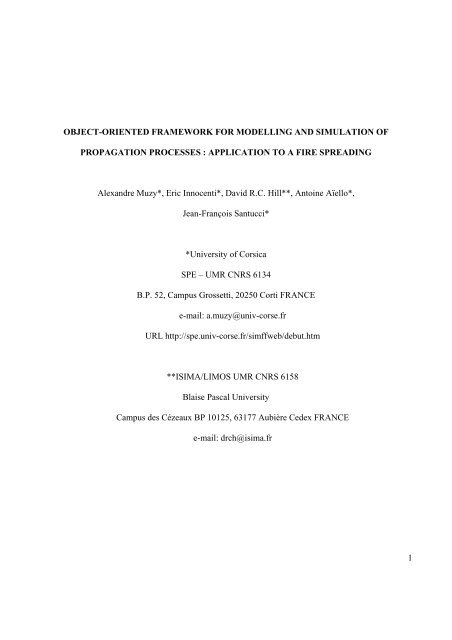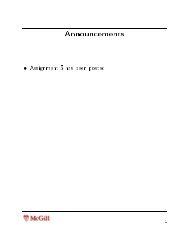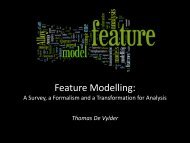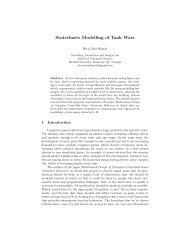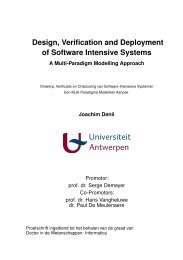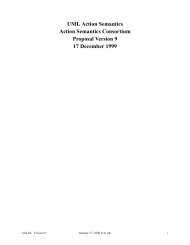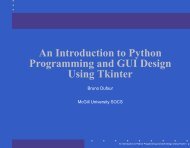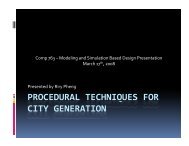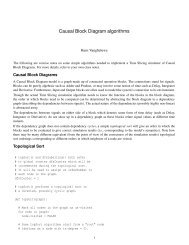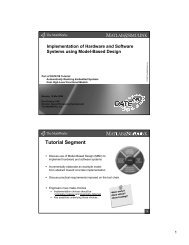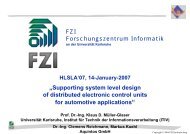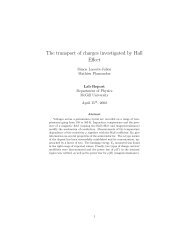Object-oriented framework for modelling and ... - ResearchGate
Object-oriented framework for modelling and ... - ResearchGate
Object-oriented framework for modelling and ... - ResearchGate
You also want an ePaper? Increase the reach of your titles
YUMPU automatically turns print PDFs into web optimized ePapers that Google loves.
OBJECT-ORIENTED FRAMEWORK FOR MODELLING AND SIMULATION OF<br />
PROPAGATION PROCESSES : APPLICATION TO A FIRE SPREADING<br />
Alex<strong>and</strong>re Muzy*, Eric Innocenti*, David R.C. Hill**, Antoine Aïello*,<br />
Jean-François Santucci*<br />
*University of Corsica<br />
SPE – UMR CNRS 6134<br />
B.P. 52, Campus Grossetti, 20250 Corti FRANCE<br />
e-mail: a.muzy@univ-corse.fr<br />
URL http://spe.univ-corse.fr/simffweb/debut.htm<br />
**ISIMA/LIMOS UMR CNRS 6158<br />
Blaise Pascal University<br />
Campus des Cézeaux BP 10125, 63177 Aubière Cedex FRANCE<br />
e-mail: drch@isima.fr<br />
1
ABSTRACT<br />
An important class of ecological problems concerns propagation processes. In ecological <strong>modelling</strong>,<br />
these phenomena generally occur on large scales <strong>and</strong> are generally difficult to efficiently simulate be-<br />
cause of the number of entities <strong>and</strong> connections between entities. Studies of this kind of phenomena lack<br />
genericity <strong>and</strong> reusability because they are often presented through the point of view of a single domain<br />
expert. Simulations made by domain experts seem to lack genericity <strong>for</strong> computer science specialists <strong>and</strong><br />
simulations developed by computer science specialists seem not to grasp <strong>modelling</strong> terminology <strong>and</strong><br />
problems of the domain experts. We propose here a general object-<strong>oriented</strong> <strong>framework</strong> <strong>for</strong> <strong>modelling</strong><br />
<strong>and</strong> simulation of propagation processes. <strong>Object</strong>-<strong>oriented</strong> techniques allow to provide genericity <strong>and</strong> re-<br />
usability. From <strong>modelling</strong> to simulation, the Unified Modeling Language (UML) provides a common<br />
means of communication between computer science specialists <strong>and</strong> domain experts. The Model Driven<br />
Architecture (MDA) is used to improve object-<strong>oriented</strong> methodology. Simulation optimisations are de-<br />
fined <strong>for</strong> implicit <strong>and</strong> explicit models of propagation. The approach is applied to the <strong>modelling</strong> <strong>and</strong><br />
simulation of fire spread. Starting from wildl<strong>and</strong> fire problems, specification levels are used to gradually<br />
specify a fire spread simulator. Each level of the study is specified in UML <strong>and</strong> thus can be reused in<br />
another wildl<strong>and</strong> fire problem.<br />
Keywords: Fire spread <strong>modelling</strong> <strong>and</strong> simulation, propagation processes, object-<strong>oriented</strong> techniques,<br />
discrete event simulation, Model Driven Architecture.<br />
2
1 INTRODUCTION<br />
Ecosystems show a high degree of heterogeneity in space <strong>and</strong> time (Jørgensen <strong>and</strong> Bendoricchio, 2001).<br />
Their study often necessitate to develop models taking into account the system evolution in both space<br />
<strong>and</strong> time. These models are spatially distributed models. Among the phenomena studied through spa-<br />
tially distributed models, propagation processes where a lateral transfer of energy, mass or in<strong>for</strong>mation<br />
occurs (fire spread, oil spills, insect infestation, watersheds etc.) represent an important class of prob-<br />
lems.<br />
Modelling propagation processes on large scales generally present two main difficulties. First the<br />
high number of intricate phenomena influencing the propagation leads to collaborate with specialists of<br />
different disciplines (ecology, physics, mathematics, biology etc.). Then the large volume of data <strong>and</strong> the<br />
number of operations the models have to manage lead to the use of computer simulation. From system<br />
analysis to programming, object-<strong>oriented</strong> methodology can be used to facilitate these two tasks.<br />
<strong>Object</strong>-<strong>oriented</strong> approach is now well recognised to benefit ecological <strong>modelling</strong> directly (Silvert,<br />
1993) <strong>and</strong> has been used in different ecosystem simulations (Sequeira et al., 1991; Baveco <strong>and</strong> Linge-<br />
man, 1992; Chen <strong>and</strong> Reynolds, 1997; Holst et al., 1997; Hill et al., 1998; Neil et al., 1999; Alfredsen<br />
<strong>and</strong> Saether, 2000; Spanou <strong>and</strong> Daoyi, 2000; Yang et al., 2002). The benefits of this approach <strong>for</strong> eco-<br />
logical <strong>modelling</strong> can be summarised as follows: (1) the safe reuse of code increases productivity; (2)<br />
clear <strong>and</strong> underst<strong>and</strong>able code is open to scientific review; (3) through easier maintenance, simulation<br />
models remain useful research tools <strong>for</strong> long periods <strong>and</strong>; (4) common <strong>modelling</strong> concepts facilitate<br />
communication within <strong>and</strong> across research groups.<br />
Simulation of propagation processes is per<strong>for</strong>med through cell space models. In ecosystem propaga-<br />
tion, l<strong>and</strong>scape is divided into parcels of l<strong>and</strong> (cells) interacting together. According to Tobler (1979), a<br />
cellular (or cell) space model consists of an infinite two-dimensional array of polygons (cells), each of<br />
3
which is, at any time, in a state determined by the states of a set of “neighbor” cells according to some<br />
uni<strong>for</strong>m location-independent rules.<br />
Cell space dynamic is generally achieved using Cellular Automata (CA) (Von Neuman, 1966). Stan-<br />
dard CA are simple mathematical idealisations of natural systems (Wolfram, 1994). They have been<br />
widely applied in ecological <strong>modelling</strong> (Spencer, 1997; Dunkerley, 1999; Sirakoulis et al., 2000;<br />
Dumont <strong>and</strong> Hill, 2001; Matsinos <strong>and</strong> Troumbis, 2002; Soares-Filho et al. 2002; El Yacoubi et al. 2003;<br />
Loibl <strong>and</strong> Toetzer, 2003). CA consist of an infinite lattice of discrete identical sites, each site taking on a<br />
finite site of, say, integer values. The values of the sites evolve in discrete time steps according to deter-<br />
ministic rules that specify the value of each site in terms of the values of neighboring sites. CA are mod-<br />
els where space, time <strong>and</strong> states are discrete (Jen, 1990).<br />
The originality of CA is to deal with relationships between parts of a system producing macro be-<br />
havioral complexity with simple local rules (Wolfram, 2002). Nevertheless, as models of real-world spa-<br />
tial phenomena, basic CA are restricted by those background conventions the simplicity of which makes<br />
the richness of their behavior so unexpected (Couclelis, 1985) (neighborhood <strong>and</strong> rules uni<strong>for</strong>mity of the<br />
cells, one discrete state per cell, closure of the system to external events <strong>and</strong> infinite lattice). There<strong>for</strong>e,<br />
CA often need to be modified <strong>for</strong> simulation purposes (Worsch, 1999; Berjak <strong>and</strong> Hearne, 2002; De la<br />
Fuente et al., 2003) . These problems can be overcome by using object-<strong>oriented</strong> techniques <strong>and</strong> discrete<br />
event simulation (DES) (Zeigler, 1976; Fishwick, 1995; Hill, 1996). Discrete events allow to focus the<br />
simulation on the active cells of a propagation domain thus optimising the simulation. DES has been re-<br />
cently used in the last decade <strong>for</strong> ecological <strong>modelling</strong> purposes (Turner et al., 1982; Huston et al., 1988;<br />
Pukkala, 1988; Auger <strong>and</strong> Faivre, 1993; Baveco <strong>and</strong> Smeulders, 1994; Breckling <strong>and</strong> Müller, 1994; Hill<br />
et al., 1994; Maxwell <strong>and</strong> Costanza, 1994; Coquillard, 1995; Laughlin et al. 2003).<br />
4
Among the disturbing propagation processes <strong>for</strong> ecosystems, fire <strong>and</strong> its influences on ecosystems<br />
remain a vast research field <strong>for</strong> numerous disciplines (biology, ecology, economy, physics, computer<br />
science etc.). Modelling such a phenomenon needs to well identify all the behavioural categories <strong>and</strong> all<br />
the interactions between these categories. The collaborative field is so large that, starting from the phe-<br />
nomenon, different abstraction levels are needed to well define the problem of interest <strong>and</strong> its relation-<br />
ships with other ones. Nowadays there is no generic method allowing to represent <strong>and</strong> guide scientists in<br />
such a field.<br />
The object technology revolution has allowed the replacement of more than twenty years old step-<br />
wise procedural refinement paradigm by the more fashionable object composition paradigm. Currently,<br />
this evolution seems to be triggering another even more radical change towards model trans<strong>for</strong>mation.<br />
As a concrete trace of this, the <strong>Object</strong> Management Group (OMG) is rapidly moving its previous <strong>Object</strong><br />
Management Architecture vision (OMA) to the newest Model Driven Architecture (MDA) (Bézivin,<br />
2001). Although the object-<strong>oriented</strong> <strong>and</strong> component-based engineering are useful <strong>and</strong> proved to be ade-<br />
quate <strong>for</strong> many applications, they also proved to be limited when dealing with concrete interoperability<br />
in large software systems. Such techniques can still be efficiently used, but they must be considered as<br />
belonging to the past. The MDA is proposing a model engineering approach, not to suppress OO model-<br />
ling or component-based <strong>modelling</strong> but to enhance what has proved to be limited.<br />
The paper is organised as follows. First, a background is provided on the MDA <strong>and</strong> the simulation of<br />
fire spread. Secondly, a complete step by step <strong>modelling</strong> <strong>and</strong> simulation process is proposed thus provid-<br />
ing a first MDA level architecture. Then, each step of the process is specified. Starting from a wildl<strong>and</strong><br />
fire phenomenon, we gradually focus on the study of fire spread through a mathematical model. After, a<br />
design <strong>framework</strong> <strong>for</strong> cell space simulation is exposed. Next, two generic architectures <strong>for</strong> simulating ef-<br />
ficiently explicit <strong>and</strong> implicit models of neighbour-to-neighbour propagation are presented. Using these<br />
5
simulation architectures, simulations of the mathematical model of fire spread are then depicted. Finally,<br />
we sum up our contribution <strong>and</strong> define new perspectives.<br />
2 BACKGROUND<br />
Modelling <strong>and</strong> simulating a phenomenon involves using different abstraction levels. From the problem<br />
definition to the simulation system, the MDA proposed by the OMG helps to specify each <strong>modelling</strong><br />
step. In a fire spread problem, different simulation approaches have been used until now. Each of these<br />
approaches has been achieved within a particular frame of interest (improvements of simulation models<br />
<strong>and</strong> ready-to-run software. Defining a higher abstraction level of design <strong>for</strong> this kind of problem is inter-<br />
esting <strong>for</strong> the specialists of the domain under study or <strong>for</strong> specialists of domains interacting with fire<br />
spread.<br />
2.1 Meta-<strong>modelling</strong> concepts<br />
A specific model usually simulates a special aspect of a complex system with a particular <strong>modelling</strong> <strong>and</strong><br />
simulation technique (Partial Differential Equations, Cellular Automata, Neural Networks, Individual<br />
Based Model with or without Genetic Algorithms, etc.). A multi-model of a complex or huge system can<br />
be achieved with a composition of different specialized models of arbitrary kinds <strong>and</strong> with several<br />
abstraction levels (cf. Fig. 1). In addition, model components can be simulated separately, thus the<br />
principle of multi<strong>modelling</strong> is to support the hierarchical refinement of heterogeneous models through<br />
functional coupling. The computational refinement or derivability of a model is a tough problem that<br />
should not be hushed up. Thorough discussions dealing with model derivation can be found in (Zeigler,<br />
1984; Fishwick, 1995).<br />
6
Multimodel<br />
attributes<br />
methods<br />
contains one<br />
to many<br />
1..*<br />
Arbitrary<br />
Model<br />
Whole<br />
Part<br />
is aggregated<br />
of one<br />
Superclass<br />
Derivedclass<br />
Basic UML legend<br />
Figure 1: Simple UML multimodel <strong>and</strong> basic UML legend<br />
Class A<br />
relation name<br />
Class B<br />
The analogy between multimodeling <strong>and</strong> object-<strong>oriented</strong> programming has been demonstrated by<br />
(Cubert, 1997; Frick, 1997; Fishwick, 1998). Furthermore multi-models can be specified by Zeigler's<br />
DEVS <strong>for</strong>malism (Discrete Event system Specifications), which presents a mathematical ground helping<br />
to h<strong>and</strong>le the well known aggregation problem (Zeigler 1976) encountered by biologists <strong>and</strong> simulation-<br />
ists. DEVS has been successfully applied to various ecological problems with multiple aggregation lev-<br />
els over the last decade. There is a close link between multi-<strong>for</strong>malism as discussed by (Zeigler 1979)<br />
<strong>and</strong> multi<strong>modelling</strong>: they are both founded on theoretic system concepts but they can be distinguished<br />
since they rely on different abstraction levels. In order to meet multi<strong>modelling</strong> requirements, Fishwick<br />
introduced a new methodology called <strong>Object</strong>-Oriented Physical Modelling (Fishwick 1996) to extend<br />
the classical object-<strong>oriented</strong> analysis <strong>and</strong> design methods in use in the simulation community (Hill<br />
1996).<br />
The history of <strong>Object</strong>-Oriented Analysis <strong>and</strong> Design methods has led to UML (Unified Modeling<br />
Language) in 1997. UML is the subject of a lot of research works <strong>and</strong> UML 2.0 has recently been<br />
adopted by the OMG as the new defacto st<strong>and</strong>ard. It provides a sound basis <strong>for</strong> MDA <strong>and</strong> represents the<br />
next evolutionary step in our ability to express <strong>and</strong> communicate system specifications. In our paper we<br />
7
etained UML <strong>for</strong> our multimodel designs since they will be more widely read using this graphical nota-<br />
tion. It proposes to various domain experts an unified view of a system <strong>and</strong> helps solving communica-<br />
tion problems (Baskent et al., 2001).<br />
Since the adoption of the Meta <strong>Object</strong> Facility (MOF) recommendation by the OMG in 1997, the<br />
importance of model engineering in the in<strong>for</strong>mation system <strong>and</strong> the software development process has<br />
rapidly increased (Breton <strong>and</strong> Bézivin, 2002). A key role is now played by the concept of meta-model in<br />
new software organisations like the OMG meta-model stack architecture. At the top of this architecture<br />
there is the MOF that provides a language <strong>for</strong> defining meta-models. This meta-meta-model aims at de-<br />
scribing a particular domain of interest by defining a set of concepts <strong>and</strong> relations between these con-<br />
cepts.<br />
A four-layer architecture has progressively taken shape. It is organised as follows:<br />
- M3: the meta-meta-model level (contains only the MOF);<br />
- M2: the meta-model level (contains any kind of meta-model described in UML);<br />
- M1: the model level (contains any model description in UML with a corresponding meta-<br />
model in M2);<br />
- M0: the concrete level (contains any real situation, unique in space <strong>and</strong> time, described by a<br />
given model).<br />
MDA is providing both an environment to define plat<strong>for</strong>m-independent models (PIM) <strong>and</strong> genera-<br />
tion services to map these models to a particular plat<strong>for</strong>m producing a plat<strong>for</strong>m-specific model (PSM).<br />
2.2 Simulation of fire spread<br />
Today, most of ready-to-run software <strong>for</strong> fire spread simulation (Albright <strong>and</strong> Meisner, 1990; Veach et<br />
al. 1994; Finney, 1995; Coleman <strong>and</strong> Sullivan, 1996; Lopes et al. 2002) <strong>and</strong> simulations of fire spreading<br />
8
on large-scale (Wu et al., 1996; Hargove et al., 2000; Miller <strong>and</strong> Yool, 2002) are based on Rothermel’s<br />
model (Rothermel, 1972). A lot of ef<strong>for</strong>t has been placed in improving simulation of Rothermel’s model.<br />
In the CA field studies pinpoint the need <strong>for</strong> developing new classes of CA <strong>for</strong> fire spreading applica-<br />
tions (Karafylidis <strong>and</strong> Thanailakis, 1997; Berjak <strong>and</strong> Hearne, 2002). Based on discrete event <strong>for</strong>malisms<br />
<strong>and</strong> object <strong>oriented</strong> programming many applications have been proposed to improve CA capabilities <strong>for</strong><br />
fire spread simulation (Vasconcelos et al. 1995; Ameghino et al. 2001; Barros <strong>and</strong> Ball, 1998; Muzy et<br />
al., 2002; Muzy et al. 2003). Unlike CA, these models can receive external updated in<strong>for</strong>mation, <strong>and</strong> the<br />
fire perimeter can be updated at any moment due to the continuous time nature of the discrete event<br />
specifications <strong>and</strong> active cells can be dynamically created <strong>and</strong> removed to save memory <strong>for</strong> large cell<br />
spaces.<br />
Nevertheless, all these last advances in the field of fire spread simulation do not deal with real-time<br />
constraints. As far as we know, if these approach improve simulation model reusability <strong>and</strong> simplify<br />
simulation model modifications, only one of them allows to simulate fire spread models requiring more<br />
computer resources under real time deadlines (Muzy et al. 2003). However, every approach has been<br />
achieved only at a simulation level without putting the study in a larger context.<br />
3 THE MODELLING AND SIMULATION PROCESS<br />
The development of a simulation system is per<strong>for</strong>med through a software development life cycle. Nu-<br />
merous works have conceptualized the whole of a part of this development cycle (Zeigler, 1976; Fish-<br />
wick, 1995; Zeigler et al. 2000). Based on these studies, two approaches proposed a complete software<br />
development life cycle (Hill, 1996; Traoré <strong>and</strong> Hill, 2001). We used these two approaches to develop a<br />
new generic software development life cycle. This cycle is presented as a meta-model of level M0 (Fig.<br />
2). It is composed of three phases: identification, engineering <strong>and</strong> integration. The aim of the cycle is to<br />
9
provide a decision support <strong>for</strong> a large application domain. This meta-model can then be reused <strong>for</strong> many<br />
simulation model development.<br />
The identification phase is the beginning of a simulation study. This phase consists in defining a<br />
problem concerning a phenomenon. Then <strong>for</strong>mulating the problem a system is identified within an ap-<br />
plication domain. <strong>Object</strong>ives are <strong>for</strong>mulated corresponding to the question the system has to answer<br />
about the phenomenon.<br />
The engineering phase consists of iterative processes through which in<strong>for</strong>mal knowledge is trans-<br />
<strong>for</strong>med into an ultimate executable <strong>for</strong>m: the programmed model. To achieve this goal, the system is<br />
specified at different levels of abstraction through a PIM. Each level of abstraction has to be verified re-<br />
garding to the last level of specification.<br />
First a domain analysis has to be conducted together with the specialist of the domain <strong>and</strong> the soft-<br />
ware designer. The objects, the relations <strong>and</strong> the behaviours brunt out are those of interest <strong>for</strong> the do-<br />
main specialist. This work constitutes the domain class model. After this phase, the object-<strong>oriented</strong><br />
analysis (OOA) consists in defining the real system with the system class model which instantiates a<br />
subset of the domain class model. Then, an object-<strong>oriented</strong> design proposes the structure <strong>and</strong> the behav-<br />
iour of a conceptual model. Different abstraction levels can be used to build the conceptual model. The<br />
last level is coded in the implemented model corresponding to the PSM. Finally, the implemented model<br />
outputs are compared to the system objectives.<br />
The integration phase exploits the simulation results to provide in<strong>for</strong>mation to a decision support<br />
(humankind <strong>and</strong>/or a computer system). The decision-makers can interact with the simulation system (1)<br />
proposing new plans of experiments an (re)use the simulation results to solve the problem; (2) improv-<br />
ing the system knowledge looking at the conceptual model; (3) sending comm<strong>and</strong>s to the physical sys-<br />
tem (if it exists) or to the conceptual system (if the system has to be (re)configured).<br />
10
PHENOMENON<br />
Problem definition<br />
Problem <strong>for</strong>mulation<br />
Domain Domain analysis<br />
State<br />
Comm<strong>and</strong><br />
<strong>Object</strong>ives<br />
System<br />
Implemented<br />
model<br />
Results<br />
Domain<br />
class<br />
model<br />
Experiments<br />
DECISION SUPPORT<br />
Conceptual<br />
model<br />
Implementation<br />
IDENTIFICATION<br />
ENGINEERING<br />
<strong>Object</strong>-<strong>oriented</strong> analysis<br />
System<br />
class<br />
model<br />
<strong>Object</strong>-<strong>oriented</strong> conception<br />
Knowledge<br />
Extraction<br />
Figure 2: Modelling <strong>and</strong> simulation life cycle<br />
INTEGRATION<br />
All the abstraction phases of Figure 2 can be specified by a meta-model. Using UML, this meta-<br />
model describes in a precise manner the interactions between the different models <strong>and</strong> entities defined<br />
above (Fig. 3). An experimental frame can be added to establish the set of experiments <strong>for</strong> which the<br />
model is valid (Zeigler, 1976, Jørgensen 2001). Separating the model description from the experiment<br />
limits the changing of experiment description <strong>for</strong> new experiments (Lorek <strong>and</strong> Sonnenschein, 1998).<br />
11
Phenomenon<br />
1..*<br />
Problem<br />
1..*<br />
Goal<br />
belongs to<br />
generates<br />
imposes<br />
*<br />
*<br />
generates<br />
constrains<br />
Domain<br />
1..*<br />
System<br />
1..*<br />
Solution<br />
*<br />
models<br />
models<br />
*<br />
*<br />
models<br />
Domain Class Model<br />
1..*<br />
System Class Model<br />
1..*<br />
Experimental Framework<br />
Conceptual Model Simulator<br />
implements<br />
Figure 3: UML meta-model of the <strong>modelling</strong> <strong>and</strong> simulation process<br />
4 APPLICATION TO FIRE SPREAD MODELLING<br />
Results<br />
constrains<br />
produces<br />
Considering wildl<strong>and</strong> fire phenomena, defining a conceptual model consists in gradually specifying a<br />
particular domain of interest. Here, starting from a domain class model of wildl<strong>and</strong> fire we focus on the<br />
fire behaviour dynamics. The system class model consists then in a fire propagation experiment. Finally,<br />
a solution is proposed through a conceptual mathematical model of fire spread. All these phases consti-<br />
tute a PIM of the model level of MDA <strong>and</strong> can be reused by other domain specialists.<br />
4.1 The domain class model<br />
Study of a wildl<strong>and</strong> fire phenomenon can be broken down into four packages (Fig. 4):<br />
1. The Human Action package encompasses development of wildl<strong>and</strong> fire prevention strategies<br />
including l<strong>and</strong> management <strong>and</strong> equipment policies as well as the elaboration of technical or<br />
regulatory solutions <strong>for</strong> reducing the number of wildl<strong>and</strong> fire ignitions <strong>and</strong> fighting fires;<br />
12
2. The Environmental Conditions package evaluates wildl<strong>and</strong> fire risks, describes geographic<br />
<strong>and</strong> climatic conditions <strong>and</strong> provides vegetation models;<br />
3. The Ecological Impact package includes the knowledge on fire consequences;<br />
4. The Fire Dynamics package provides a description of the fire behaviour dynamics.<br />
Figure 5 details the fire dynamics package. The study of the fire behaviour dynamics consists in de-<br />
scribing chronologically the ignition, the propagation <strong>and</strong> finally the extinction. These phases can be<br />
mathematically described. Mathematical models provide the flame front position using the temperature<br />
distribution in complex fuel.<br />
WILDLAND FIRE DOMAIN<br />
HUMAN ACTION ENVIRONMENTAL<br />
CONDITIONS<br />
FIRE DYNAMICS<br />
ECOLOGICAL IMPACT<br />
Figure 4: Package diagram of fire domain breakdown<br />
To achieve this goal an experiment is used to provide input data or in<strong>for</strong>mation <strong>and</strong> to validate the<br />
model. A fire spread experiment obviously modifies the real world to collect data of interest. Using an<br />
experiment, the propagation domain is described through the geography, the vegetation <strong>and</strong> the climate.<br />
Depending on the scale of the experiment <strong>and</strong> of the degree of precision the modeller has, different types<br />
of mathematical models can be used. To achieve real-time simulation, complexity of fire spread <strong>and</strong> data<br />
13
volume require having simple mathematical models capable of predicting the main behavioral features<br />
of fire.<br />
Based on Weber’s classification (1990), three kinds of mathematical models <strong>for</strong> fire propagation can<br />
be identified according to the methods used in their construction. The first type of models are statistical<br />
models (McArthur, 1966), which make no attempt at involving physical mechanisms, being merely a<br />
statistical description of test fires. The results can be very successful in predicting the outcome of similar<br />
fires to the test fires. However, the lack of a physical basis means that the statistical models must be used<br />
cautiously outside the test conditions. The second category of models incorporates semi-empirical mod-<br />
els (Rothermel, 1972) based on the principle of energy conservation but which do not distinguish be-<br />
tween the different mechanisms of heat transfer. Rothermel’s stationary model is a one-dimensional<br />
model, in which a second dimension can be obtained using propagation algorithms (Richards, 1990) in-<br />
tegrating empirically wind <strong>and</strong> slope. Finally, physical models (Albini, 1985) integrate wind <strong>and</strong> slope<br />
effects in a more robust manner describing the various mechanisms of heat transfer <strong>and</strong> production.<br />
Physical mechanisms are described using a chemical, thermal <strong>and</strong> mechanical definition of basic fire<br />
phenomena. Hence, physical <strong>and</strong> semi-empirical models use the definition of basic fire phenomena to<br />
physically describe fire propagation.<br />
14
Statistical Model<br />
statisticalDescription() :<br />
<br />
Fire Behaviour Dynamics<br />
ignition() :<br />
propagation() :<br />
extinction() :<br />
4.2 The system class model<br />
Mathematical Model of Fire Spread<br />
domainTemperatures : Vector<br />
flameFrontPosition() :<br />
Semi-empirical Model<br />
energyConservation() :<br />
uses<br />
uses<br />
vegetation<br />
geography<br />
climate<br />
Model from Physics<br />
heatTransferMechanisms() :<br />
Propagation Domain<br />
chemical<br />
thermal<br />
mechanical<br />
Basic Fire Phenomena<br />
Figure 5: Excerpt of the fire domain class model: the Fire Dynamics package<br />
uses<br />
uses<br />
uses<br />
Experiment<br />
modifies reads data<br />
Real World<br />
We used data of experimental fires conducted on Pinus Pinaster litter, in a closed room without any air<br />
motion, at the INRA (Institut National de la Recherche Agronomique) laboratory near Avignon, France<br />
(Balbi et al. 1999). Rigorous experiments were per<strong>for</strong>med in order to observe fire spread <strong>for</strong> point-<br />
ignition fires under no slope <strong>and</strong> no wind conditions. The experimental apparatus was composed of a<br />
one square meter aluminium plate protected by s<strong>and</strong>. A porous fuel bed was used, made up of pure oven<br />
dried pine needles spread as evenly as possible on the total area of the combustion table in order to ob-<br />
15
tain a homogeneous structure. The experiment consisted in igniting a point using alcohol. The resulting<br />
spread of the flame across the needles was closely observed with a camera <strong>and</strong> thermocouples.<br />
4.3 The Conceptual model<br />
Once the laboratory experiment has been defined, a mathematical model has to be designed to simulate<br />
the fire spread. The large number of data <strong>and</strong> phenomena leads to a model simplification. Nevertheless,<br />
the description of the laboratory fire spread is a simplified case of fire spread. Actual fire spread often<br />
necessitates to combine different mathematical models.<br />
Statistical Model<br />
statisticalDescription() :<br />
Mathematical Model of Fire Spread<br />
domainTemperatures : Vector<br />
flameFrontPosition() :<br />
Semi-empirical Model<br />
energyConservation() :<br />
Focuses on the main<br />
mechanisms involved<br />
in a fire spread<br />
Figure 6: Mathematical <strong>modelling</strong> of fire spread<br />
Model from Physics<br />
heatTransferMechanisms() :<br />
Reduced Model from Physics<br />
Among the models from physics (Fig. 6), the multiphase approach which takes into consideration<br />
the finest mechanisms involved in fire spreading is the most complete <strong>modelling</strong> that has been devel-<br />
oped so far (Grishin, 1997; Larini et al., 1997). Although the simulation of such models requires very<br />
long calculation time, the multiphase approach can be used to improve or develop simpler models dedi-<br />
cated to fire spread simulators (Giroux, 1997; Dupuy <strong>and</strong> Larini 2001). To achieve such a simple model,<br />
16
we have developed a strategy based on the reduction of multiphase models. This leads to a reduced<br />
physical model focusing on the main mechanisms involved in fire spreading (Balbi et al. 1999). This last<br />
model is non-stationary <strong>and</strong> two-dimensional.<br />
This model uses elementary cells of earth <strong>and</strong> plant matter. Under no wind <strong>and</strong> no slope conditions,<br />
the temperature of each cell is represented by the following PDE:<br />
∂T<br />
∂σ v<br />
= −k<br />
( T −Ta<br />
) + K∆T<br />
−Q<br />
in the domain (1a)<br />
∂t<br />
∂t<br />
σv = σv0 if T < Tig (1b)<br />
σv = σv0.e -α(t-t ig ) if T ≥ Tig (1c)<br />
T(x,y,t) = Ta at the boundary (1d)<br />
T(x,y,t) ≥ Tig <strong>for</strong> the burning cells (1e)<br />
T(x,y,0) = Ta <strong>for</strong> the non burning cells at t=0 (1f)<br />
Where, considering a cell, Ta (27 °C ) is the ambient temperature, Tig (300 °C) is the ignition tem-<br />
perature, tig (s) is the ignition time, T (°C) is the temperature, K (m².s -1 ) is the thermal diffusivity, Q<br />
(m².°C / kg) is the reduced combustion enthalpy, ∆ is the Laplacian in two-dimensional Cartesian coor-<br />
dinates, α (s -1 ) combustion time constant, σv (kg.m -2 ) is the vegetable surface mass, σv0 (kg.m -2 ) is the<br />
initial vegetable surface mass (be<strong>for</strong>e the cell combustion).<br />
The model parameters are identified from experimental data of temperature versus time. The heat<br />
transfer of the model is sketched in Figure 7.<br />
17
K ∆T<br />
( T T )<br />
k −<br />
a<br />
∂ ν<br />
σ<br />
Q K ∆T<br />
∂t<br />
Figure 7: Heat transfer of the semi-physical model<br />
The equation (1a) has to be numerically solved. Although analytical solutions exist <strong>for</strong> simple<br />
mathematical models of fire spread (Weber, 1989), generally, numerical methods are necessary to solve<br />
complex mathematical models of fire spread. Two numerical methods can be used to discretise the<br />
model: the Finite Element Method (FEM) <strong>and</strong> the Finite Difference Method (FDM). In a previous study,<br />
we applied both methods (Santoni, 1997). Although they provided the same results, the FEM appeared<br />
more complex to implement, <strong>and</strong> involved longer execution time. Thus, the FDM was chosen because of<br />
its simplicity <strong>and</strong> equally good per<strong>for</strong>mance.<br />
The propagation domain is divided into a rectangular grid. With the FDM, the equation (1a) can be<br />
discretised with both explicit <strong>and</strong> implicit schemes. Simulation models obtained with an explicit scheme<br />
are easier to implement while those obtained with an implicit scheme are numerically more stables.<br />
Using an explicit scheme, a discrete time model, well suited <strong>for</strong> computer simulation, is retained.<br />
The study domain is meshed uni<strong>for</strong>mly with cells of 1-cm² <strong>and</strong> a time step of 0.01 s. The following al-<br />
gebraic equation is obtained:<br />
T<br />
k<br />
k + 1 k k<br />
k k ⎛ ∂σ v ⎞<br />
i,<br />
j = a(<br />
Ti−1,<br />
j + Ti+<br />
1,<br />
j ) + b(<br />
Ti,<br />
j−1<br />
+ Ti,<br />
j+<br />
1)<br />
+ cQ⎜<br />
⎟ +<br />
i , j<br />
⎝ ∂t<br />
⎠<br />
dT<br />
k<br />
i,<br />
j<br />
(2)<br />
18
Where Tij is the grid node temperature. The coefficients a, b, c <strong>and</strong> d depend on the time step <strong>and</strong><br />
mesh size considered. At each time step k, every temperature is calculated <strong>for</strong> the next time step k+1.<br />
Using an implicit scheme, the equation (1a) is discretised onto the domain propagation <strong>and</strong> leads to a<br />
linear system. The system is solved using the Jacobi iterative method (Sibony <strong>and</strong> Mardon 1998). The<br />
study domain is meshed uni<strong>for</strong>mly with cells of 1-cm² <strong>and</strong> a time step of 0.1 s.<br />
T<br />
k+<br />
1<br />
i,<br />
j<br />
= a'(<br />
T<br />
k+<br />
1<br />
i−1,<br />
j<br />
+ T<br />
k+<br />
1<br />
i+<br />
1,<br />
j<br />
) + b'(<br />
T<br />
k+<br />
1<br />
i,<br />
j−1<br />
+ T<br />
k+<br />
1<br />
i,<br />
j+<br />
1<br />
⎛ ∂σ v ⎞<br />
) + c'Q⎜<br />
⎟<br />
⎝ ∂t<br />
⎠<br />
k<br />
i , j<br />
+ d'T<br />
k<br />
i,<br />
j<br />
Every temperature is calculated at the same time step. A convergence condition is used to pass at<br />
next time step.<br />
5 DESIGN FRAMEWORK FOR CELL SPACE SIMULATION<br />
Different choices of software architectures can be selected to simulate propagation processes. It is not<br />
often so easy <strong>and</strong> time consuming to develop efficient, reusable programs which are also easy to main-<br />
tain. However, <strong>for</strong> a class of systems, different programming techniques <strong>and</strong> principles can be identified<br />
to propose a reusable software architecture. A <strong>framework</strong> allows to guide the modeller in the implemen-<br />
tation phase. It is an abstract idea of an application structure, i.e. a reusable design <strong>for</strong> solutions to prob-<br />
lems in some particular domain, than can be a system or a part of a system (Campos <strong>and</strong> Hill, 1998).<br />
5.1 Conceptual model <strong>for</strong> cell space simulation<br />
To achieve a simulation model of a cell space we distinguish different objects (Fig. 8). First, we separate<br />
the simulation model into a Simulator package <strong>and</strong> a World <strong>modelling</strong> package. The Simulator package<br />
controls <strong>and</strong> schedules events. The World <strong>modelling</strong> package represents the model of real world to<br />
simulate. Separating computer model <strong>and</strong> simulator allows to reuse a simulator <strong>for</strong> many models thus<br />
reducing development time (Zeigler, 2000).<br />
(3)<br />
19
Modelling with object-<strong>oriented</strong> approaches is based on the concepts of hierarchy <strong>and</strong> taxonomy<br />
which are the two organising principles in ecology (Sequeira et al. 1991). By composition, the simula-<br />
tion of a cell space can be constructed in a hierarchical way (Fig. 9). We use the system entity structure<br />
(SES) to represent the simulation model composition (Zeigler, 1984). SES allows to refine object-<br />
<strong>oriented</strong> hierarchical trees generally provided in ecological <strong>modelling</strong> literature (Chen, 1997; Baveco<br />
<strong>and</strong> Lingeman, 1992) differentiating single <strong>and</strong> multi-decomposition. In a SES a single bar (|) represents<br />
single decomposition <strong>and</strong> a triple bar (|||) represents multi-decomposition.<br />
The Simulator class is composed of object classes such as the synchronization kernel (Synchro. Ker-<br />
nel) that uses the time (Time) to sort <strong>and</strong> schedule environmental events (Events) that are heaped in an<br />
event list (Event List). Using the simulation kernel, the Simulator manages the simulation of the World<br />
<strong>modelling</strong> package. The <strong>for</strong>mer is also composed of the Cell Space class <strong>and</strong> the Experimental Frame<br />
one. Here, the Experimental Frame can be seen as an object selecting data from real world <strong>and</strong> validat-<br />
ing simulation results. In the World Modelling Package, behavior <strong>and</strong> structure are separated. In eco-<br />
logical propagation, structure concerns parcels of l<strong>and</strong>scape. More precisely structure concerns the value<br />
of the model’s state variables in each parcel (biomass, presence of an organism, food resources, etc.)<br />
(Laval, 1996; Congleton et al., 1997). Each state variable of a parcel (which generally corresponds to<br />
rasters of Geographical In<strong>for</strong>mation System (GIS)) is embedded in an array of object cells (Parcel At-<br />
tributes) thus containing multiple state variables. Dynamics of the parcels changing one of their state<br />
variables is achieved through a Vector of active cells.<br />
Modelling of ecological systems needs different abstraction levels communicating together. More<br />
generally, holistic <strong>and</strong> reductionistic views can be used to complementarily specify a model (Goguen<br />
<strong>and</strong> Varela, 1979; Jørgensen, 2001). Besides the cell’s rules used to represent the system dynamics at a<br />
20
low level (Local Rule), rules can be used at a higher level (Global Rule) in the Cell space to represent<br />
the evolution of the global state of the system.<br />
Simulator Package<br />
World Modelling Package<br />
1..*<br />
Time uses Synchro. Kernel manages<br />
Event List<br />
reads data<br />
generation() :<br />
validation() :<br />
analysis() :<br />
Parcel Attributes<br />
provides results<br />
Experimental Frame<br />
1..*<br />
uses<br />
Simulator<br />
Cell Space Vector of Active Cells<br />
Cell<br />
Rule<br />
1..*<br />
Global Rule<br />
Local Rule<br />
1..*<br />
1..*<br />
0..*<br />
cellState<br />
cellPhase<br />
1..*<br />
sends an event<br />
Figure 8: Proposition of a design <strong>framework</strong> <strong>for</strong> cell space simulation<br />
<strong>Object</strong> Simulator<br />
Cell Space<br />
Simulation Kernel<br />
Experimental Frame<br />
Parcel Attributes<br />
Vector of Active Cells Cell<br />
Figure 9: The system entity structure <strong>for</strong> the cell space simulation<br />
Event<br />
modifies<br />
0..*<br />
21
5.2 Coupling of world model <strong>and</strong> data l<strong>and</strong>scape<br />
Lets now focus on the coupling of the World model <strong>and</strong> data l<strong>and</strong>scape. The World object can be con-<br />
sidered as the object container possessing all entities in the simulation <strong>and</strong> being coupled with the data<br />
l<strong>and</strong>scape. In large propagation phenomena, the latter is generally provided by a GIS. This case can be<br />
h<strong>and</strong>led easily by means of the Experimental frame (Vasconcelos et al., 1995). The relevant issues we<br />
retain are: the number of active <strong>and</strong> passive cells, the spatial environment dimension <strong>and</strong> its scale of rep-<br />
resentation, the velocity per<strong>for</strong>mance <strong>and</strong> the memory capacity required.<br />
Spatial-<strong>oriented</strong> structure<br />
E<br />
D<br />
A<br />
C<br />
B<br />
Entity-<strong>oriented</strong> structure<br />
A<br />
B<br />
C<br />
D<br />
E<br />
Position (2,4)<br />
Position (4,7)<br />
Position (6,6)<br />
Position (5,3)<br />
Position (3,1)<br />
Figure 10: Choices of world data structure <strong>for</strong> DES<br />
In accordance with these issues, two basic approaches can be retained to encapsulate <strong>and</strong> to<br />
manipulate the world data structure (Campos <strong>and</strong> Hill, 1998) (Fig. 10). The first is spatial-<strong>oriented</strong> <strong>and</strong><br />
the second is entity-<strong>oriented</strong>. In a spatial-<strong>oriented</strong> approach we can see the world like a grid providing a<br />
matrix of positions where a position can be assigned to an entity. This approach is suitable <strong>for</strong> simula-<br />
tions with a large number of entities <strong>and</strong> where the computer time per<strong>for</strong>mance is more important than<br />
memory constraints. The second approach is <strong>for</strong> simulations with few simulation entities <strong>and</strong> when we<br />
do not want to use the large memory space required by a spatial localisation table (matrix of positions).<br />
Thus, localisation in<strong>for</strong>mation is saved inside the entity instead of having a matrix of position where a<br />
position points to the entity. As a consequence, little memory space will be lost in the simulation imple-<br />
22
mentation. However, the computer time per<strong>for</strong>mance will decrease since to get an in<strong>for</strong>mation about en-<br />
vironmental position we may have to consult all entities in the worst case.<br />
For large-scale cell space simulation, a combination of the two first approaches can be achieved<br />
using a spatial-<strong>oriented</strong> representation <strong>for</strong> the Grid of state variable <strong>and</strong> an entity-<strong>oriented</strong> representation<br />
<strong>for</strong> the Vector of active cells (Fig. 8). To respect real time deadlines, dynamic allocation has to be sup-<br />
pressed <strong>for</strong> these classes. Indeed, <strong>for</strong> significant numbers of object instantiation/deletion dynamic alloca-<br />
tion is inefficient <strong>and</strong> a specialised static allocation have to be designed (Stroustrup, 2000). A pre-<br />
dimensioning via large static arrays <strong>and</strong> vectors can be easily achieved thanks to current modern com-<br />
puter memory capabilities.<br />
The Vector of active cells is updated using a DES. A start-index <strong>and</strong> an end-index are delimit-<br />
ing the current calculation domain on the vector. Thus initial active cells that return in a quiescent state<br />
during a simulation run can be dynamically ignored in the main loop. At each time step, by modifying<br />
the value of the indexes, new tested cells can be added to the calculation domain <strong>and</strong> cells that return in<br />
a quiescent state are removed from the <strong>for</strong>mer.<br />
6 SIMULATION MODELS FOR NEIGHBOUR-TO-NEIGHBOUR PROPAGATIONS<br />
The design <strong>framework</strong> previously introduced is used here to implement an optimized simulation of a<br />
neighbour-to-neighbour propagation. In section 4 we saw that the numerical resolution of the PDE (1a)<br />
leads to two algebraic equations (2) <strong>and</strong> (3). The difference between equation (2) <strong>and</strong> (3) are (1) the<br />
condition used to increment the discrete time base added <strong>for</strong> equation (3); (2) a modification of the value<br />
of the equation parameters; (3) a different value of time step. Using the previous design <strong>framework</strong>,<br />
most of the classes previously defined can be reused <strong>and</strong> few modifications have to be achieved on some<br />
classes. Modification (1) leads to test the event occurrences in the Synchro. Kernel (Fig. 7). Modifica-<br />
23
tions (2) <strong>and</strong> (3) induce little modifications of the Time <strong>and</strong> Cell classes. This phase represents the last<br />
abstraction level of a PIM.<br />
6.1 The pure event scheduling approach<br />
For neighbour-to-neighbour propagation, a generic rule can be implemented in the Cell space class to<br />
control the evolution of the calculation domain (corresponding to the set of active cells). To control the<br />
domain evolution, propagation states have been added to the cells (testing <strong>for</strong> the cells at the edge of the<br />
propagation, non testing <strong>for</strong> the cells whose state is not tested at each state transition <strong>and</strong> quiescent <strong>for</strong><br />
the inactive cells in quiescent state).<br />
A neighbour-to-neighbour propagation example is sketched in Figure 11 <strong>for</strong> a cardinal neighbor-<br />
hood. In our algorithm, only the bordering cells test their neighborhood, this allows to reduce the num-<br />
ber of testing cells. The test depends on the cells’ state. If the tested cell fulfils the requested condition,<br />
the cell becomes an active cell <strong>and</strong> new tested neighboring cells are added to the set of active cells.<br />
?<br />
?<br />
?<br />
? ? ? ?<br />
?<br />
?<br />
t t+h<br />
?<br />
t+2h<br />
Propagation states<br />
non testing testing<br />
quiescent<br />
Figure 11: Evolution of the calculation domain<br />
?<br />
24
In the case of fire spread, two grids of state variables are used. One to store the propagation states,<br />
the other to store the temperatures of cells. As the phase of a cell (unburned, burning <strong>and</strong> burned) only<br />
depends on the temperature of the cell, the phases are directly embedded in the cell objects.<br />
6.2 The activity scanning modification<br />
Activity scanning (also known as the two-phase approach) was first introduced by (Buxton <strong>and</strong> Laski,<br />
1962). An activity is what trans<strong>for</strong>ms the state of an object over a period of time. An activity is initiated<br />
by the occurrence of an event <strong>and</strong> is ended by the occurrence of another event. Under the activity scan-<br />
ning conceptual <strong>framework</strong>, the modeller describes an activity in two parts: condition <strong>and</strong> actions.<br />
In order to try to remedy the execution inefficiency of activity scanning (Tocher, 1963) suggested<br />
the three-phase approach which combines activity scanning <strong>and</strong> event scheduling. A classification is<br />
made to separate unconditional <strong>and</strong> conditional activities. The three-phase approach executes sequen-<br />
tially (Pidd, 1984) (1) the time-scanning (A Phase); (2) the bound-to-occur or book-keeping activities<br />
that represent the unconditional state changes (unconditional events) which can be scheduled in advance<br />
(B phase); (3) the conditional or co-operative activities that represent the state changes which are condi-<br />
tional upon the co-operation of different objects or the satisfaction of specific (compound) conditions (C<br />
phase).<br />
25
START<br />
Time Flow Mechanism<br />
Simulation Time SCAN A Phase<br />
Time Flow Mechanism<br />
Iteration Time SCAN A' Phase<br />
EXECUTE ALL CELLS' TRANSITION FUNCTION B phase<br />
Does all cells'<br />
state converge<br />
?<br />
Terminate<br />
Simulation ?<br />
END<br />
Yes<br />
No<br />
SCAN ALL CELLS C phase<br />
ACTIVITY 1<br />
CellSpreadState == 'inTest'<br />
<strong>and</strong><br />
CellState == spreadCondition<br />
Add neighbouring cells to the active set<br />
No<br />
Yes<br />
ACTIVITY 2<br />
CellPhase == 'quiescent'<br />
Remove the cell from the active set<br />
Figure 12: Three-phase approach modification <strong>for</strong> implicit model simulation<br />
Figure 12 depicts an adaptation of the three-phase approach <strong>for</strong> the simulation of implicit models. A<br />
principal time scanning loop is in charge of the simulation time (A phase). However, the A phase has<br />
been doubled by a smaller loop in charge of the iteration time base (A’ phase). As long as the states of<br />
all cells do not converge, the transition function of a cell is executed. Once the state of a cell converges<br />
it is added or removed from the calculation domain (C phase).<br />
26
7 RESULTS OF FIRE SPREAD SIMULATION<br />
For the PSM we chose to program our implemented model in C++ <strong>for</strong> efficiency reasons. We used three<br />
techniques <strong>for</strong> the simulation phase (Balci <strong>and</strong> Sargent, 1989; Youngblood <strong>and</strong> Pace, 1995; Hill et al.,<br />
1996) (1) comparison validation: comparison of simulation results with an experiment; (2) confrontation<br />
validation: asking physicists if the results <strong>and</strong> behaviour of the simulation model were consistent; (3)<br />
graphic validation: using visualisation <strong>and</strong> animation to make use of the human ability to apprehend spa-<br />
tial relationships.<br />
Figure 13 shows a comparison of the simulated <strong>and</strong> experimental fire fronts obtained <strong>for</strong> a point-<br />
ignition. Black squares represent the experimental fire fronts. Figure 14 represents the evolution of the<br />
active cells around the fire fronts. Finally, Figures 15 <strong>and</strong> 16 depict the execution time gain (on a 500<br />
MHz Pentium III processor) obtained focusing on the active cells of the propagation domain. We can<br />
remark that this gain is more important <strong>for</strong> a three-phase simulation. Indeed, <strong>for</strong> the implicit method if<br />
the time step is greater than the explicit one (of ten times), the number of iteration per time step is lower<br />
than ten. Moreover, the number of active cells is approximately equivalent at each time step. Hence, if at<br />
the end of the simulation the three-phase method will execute 10 million of cell transition functions, the<br />
pure discrete event one corresponding to the explicit model necessitates 56 millions of cell transition<br />
functions.<br />
27
Y<br />
100<br />
80<br />
60<br />
40<br />
20<br />
0<br />
0 25 50 75 100<br />
X<br />
T(K)<br />
1292<br />
1226<br />
1160<br />
1093<br />
1027<br />
961<br />
895<br />
829<br />
763<br />
697<br />
631<br />
564<br />
498<br />
432<br />
366<br />
Y<br />
100<br />
80<br />
60<br />
40<br />
20<br />
0<br />
0 25 50 75 100<br />
(a) (b)<br />
Figure 13: Simulated <strong>and</strong> experimental fire fronts at: (a) t=122s <strong>and</strong> (b) t=144s<br />
Y<br />
100<br />
90<br />
80<br />
70<br />
60<br />
50<br />
40<br />
30<br />
20<br />
10<br />
50 100<br />
X<br />
X<br />
0 25 50 75 100<br />
X<br />
Figure 14: Evolution of the active cells<br />
Y<br />
100<br />
90<br />
80<br />
70<br />
60<br />
50<br />
40<br />
30<br />
20<br />
10<br />
0<br />
T(K)<br />
1292<br />
1226<br />
1160<br />
1093<br />
1027<br />
961<br />
895<br />
829<br />
763<br />
697<br />
631<br />
564<br />
498<br />
432<br />
366<br />
28
Execution time<br />
(log. scale in min.)<br />
10000<br />
1000<br />
100<br />
10<br />
1<br />
0 100 200 300 400 500<br />
Continuous CA<br />
Number of cells (thous<strong>and</strong>)<br />
Discrete event simulation <strong>and</strong> calculation domain evolution<br />
Figure 15: Execution time gain using a discrete event simulation focusing on active cells of the<br />
Execution time<br />
(log. scale in min.)<br />
10000<br />
1000<br />
100<br />
10<br />
1<br />
propagation domain<br />
0 100 200 300 400 500<br />
Number of cells (thous<strong>and</strong>)<br />
Three-phase simulation of a continuous CA<br />
Three-phase simulation <strong>and</strong> calculation domain evolution<br />
Figure 16: Execution time gain using a three-phase simulation focusing on active cells of the<br />
propagation domain<br />
29
8 CONCLUSION<br />
We presented a method <strong>for</strong> <strong>modelling</strong> wildl<strong>and</strong> fires <strong>and</strong> simulating fire spread. This method uses both<br />
latest advances in the field of software engineering <strong>and</strong> new developed simulation <strong>and</strong> <strong>modelling</strong> tools.<br />
Except <strong>for</strong> the PSM all the PIMs can be reused in another propagation problem or by another research<br />
domain on wildl<strong>and</strong> fires. The final PSM developed using the MDA architecture proved to be efficient<br />
in terms of execution time <strong>and</strong> has been qualitatively validated against experimental data.<br />
Model composition seems to be well suited to ecological <strong>modelling</strong>. Model representation allows<br />
aggregating different ecological features providing a problem overview. Description of model interac-<br />
tions facilitates the communication between specialists of different research domains.<br />
Structure or concepts of this new <strong>framework</strong> can be used by other object-<strong>oriented</strong> approaches de-<br />
signed <strong>for</strong> cell space simulations which generally lack genericity. Modules of the <strong>framework</strong> can be<br />
adapted <strong>for</strong> new problems integrating specific data (experiments <strong>and</strong> parcel attributes), behaviors (rules<br />
of the cells or cell space) or time schemes (simulator part of the <strong>framework</strong>). Optimization concepts<br />
concentrating the simulation on active cells can also be reused to significantly reduce simulation time of<br />
large cell spaces.<br />
The method needs now to be tested to other ecological systems <strong>and</strong> thus refined <strong>for</strong> the encountered<br />
problems. In the wildl<strong>and</strong> fire field other subdomains than fire spread can be studied in more detail <strong>and</strong><br />
connections to the fire spread models can be developed. Other PSM can also be tested using our first ar-<br />
chitecture. Once sufficient work will be done in a specific application domain, UML profiles (Fuentes<br />
<strong>and</strong> Vallecillo, 2001) will be able to be designed <strong>for</strong> these application. These profiles focus on the com-<br />
mon properties of systems of the same application domain. Domain experts can then use these macro-<br />
architectures as the software designers used the well known design pattern micro-architectures (Gamma<br />
et al., 1995, Holst et al., 1997).<br />
30
ACKNOWLEDGMENTS<br />
The authors gratefully acknowledge the Assistant Professor Paul Antoine Santoni of the University of<br />
Corsica <strong>for</strong> his help in applying our methodology to the <strong>modelling</strong> <strong>and</strong> simulation of fire spread.<br />
REFERENCES<br />
Albini, F.A., 1985. A model <strong>for</strong> fire spread in wildl<strong>and</strong> fuels by radiation. Comb. Sci. <strong>and</strong> Tech., 42: 229-<br />
258.<br />
Albright, D., Meisner, B.N., 1999. Classification of fire simulation systems. Fire Management Notes, 59(2): 5-<br />
12.<br />
Alfredsen, K., Sæther, B., 2000. An object-<strong>oriented</strong> application <strong>framework</strong> <strong>for</strong> building water resource<br />
in<strong>for</strong>mation <strong>and</strong> planning tools applied to the design of a flood analysis system, Environmental Model-<br />
ling <strong>and</strong> Software, 15(3): 215-224.<br />
Ameghino, J., Tróccoli, A., Wainer, G., 2001. Models of complex physical systems using Cell-DEVS.<br />
Proceedings of Annual Simulation Symposium, Seattle, WA. U.S.A..<br />
Andrews, P.L., Bevins, C.D., 1998. Update <strong>and</strong> Expansion of the BEHAVE Fire Behavior Prediction<br />
System. Technical report.<br />
Auger, P., Faivre, B., 1993. Propagation of extinction waves in spatial models of interspecific competi-<br />
tion <strong>and</strong> selective predation. Acta Oecol. 14(6): 781–805.<br />
31
Balbi, J. H., Santoni, P. A., Dupuy, J.L., 1999. Dynamic <strong>modelling</strong> of fire spread across a fuel bed. Int. J.<br />
of Wildl<strong>and</strong> Fire, 9: 275-284.<br />
Balci, O., Sargent, R.E., 1989. Guidelines <strong>for</strong> selecting <strong>and</strong> using simulation model verification tech-<br />
niques. Proceedings of the Winter Simulation Conference, pp. 559–568.<br />
Barros, F.; Ball, G.L., 1998. Fire modeling using dynamic structure cellular automata. III International<br />
Confer. On Forest Fire Research, 14 th Conference on Fire <strong>and</strong> Forest Meteorology, VOL I, PP. Luso,<br />
879-888. 16/20 November 1998.<br />
Baskent, E.Z., Wightman, R.A., Glenwood, A.J., Zhai, Y., 2001. <strong>Object</strong>-<strong>oriented</strong> abstraction of com-<br />
temporary <strong>for</strong>est management design. Ecol. Modelling, 143: 147-164.<br />
Baveco, J.M., Lingeman, R., 1992. An object-<strong>oriented</strong> tool <strong>for</strong> individual-<strong>oriented</strong> simulation: host para-<br />
sitoid system application. Ecol. Modelling, 61: 267-286.<br />
Baveco, J.M., Smeulders, A.M.W., 1994. <strong>Object</strong>s <strong>for</strong> simulation: smaltalk <strong>and</strong> ecology. Simulation, 62<br />
(1): 42–57.<br />
Berjak, S.G., Hearne, J.W., 2002. An improved cellular automaton model <strong>for</strong> simulating fire in a spa-<br />
tially heterogeneous Savanna system. Ecol. Modelling, 148: 133-151<br />
Bézivin, J., 2001. From object composition to model trans<strong>for</strong>mation with the MDA. Proceedings of the<br />
TOOLS’ USA August 2001, Santa Barbara, USA.<br />
Breckling, B., Muller, F., 1994. Current trends in ecological <strong>modelling</strong> <strong>and</strong> the 8th ISEM conference on<br />
the state-of-theart. Ecol. Model., 75: 667–675.<br />
Breton, E., Bézivin, J., 2002. Weaving definition <strong>and</strong> execution aspects of process meta-models Pro-<br />
ceedings of the 35th Annual Hawaii International Conference on System Sciences (HICSS'02), Big Is-<br />
l<strong>and</strong>, Hawaii.<br />
Buxton, J.N., Laski, J.G., 1962. Control <strong>and</strong> simulation language. The Computer Journal, 5: 194-199.<br />
32
Campos, A., Hill, D.R.C., 1998. An Agent-based Framework <strong>for</strong> Visual-Interactive Ecosystem Simula-<br />
tions. SCS Transactions, 15: 139-152.<br />
Chen, J., Reynolds, J.F., 1997. GePSi: A generic plant simulator based on object-<strong>oriented</strong> principles.<br />
Ecol. Modelling, 94: 53-66.<br />
Coleman, J. R.; Sullivan, A.L., 1996. A Real-time Computer Application <strong>for</strong> the Prediction of Fire Spread<br />
across the Australian L<strong>and</strong>scape. Simulation, 67(4): 230-240.<br />
Congleton, R.C., Pearce, B.R., Beal, B.F., 1997. A C++ implementation of an individual/l<strong>and</strong>scape<br />
model. Ecol. Modelling, 103: 1-17.<br />
Coquillard, P., 1995. Simulation of the cyclical process of heathl<strong>and</strong>s. Induction of mosaics structures,<br />
evolution to irreversible states. Ecol. Model., 80: 97–111.<br />
Couclelis, H., 1985. Cellular worlds: A <strong>framework</strong> <strong>for</strong> <strong>modelling</strong> micro-macro dynamics. Environment<br />
<strong>and</strong> Planning A, 17: 585-596.<br />
Cubert, R.M., Goktekin, T., Fishwick, P.A., 1997. MOOSE : Architecture <strong>for</strong> an <strong>Object</strong>-Oriented Mul-<br />
timodeling Simulation System, Enabling Technology <strong>for</strong> Simulation Science, SPIE, AeroSense 1997,<br />
Conference, Orl<strong>and</strong>o, FL.<br />
De la Fuente, L.F., Causon, D.M., Ingram, D.M., Mingham, C.G., Raper, D.W., 2003. Towards simulat-<br />
ing urban canyon circulations with a 2D lattice Boltzmann model, Environmental Modelling & Soft-<br />
ware, 18(1) 71-79.<br />
Dumont, B., Hill, D., 2001. Multi-agent simulation of group <strong>for</strong>aging in sheep: effects of spatial mem-<br />
ory, conspecific attraction <strong>and</strong> plot size.", Ecological Modelling, 141: 201-215.<br />
Dunkerley, D.L., 1999. B<strong>and</strong>ed chenopod shrubl<strong>and</strong>s of arid Australia: <strong>modelling</strong> responses to interan-<br />
nual rainfall variability with cellular automata. Ecol. Model., 121: 127-138.<br />
33
Dupuy, J.L., Larini, M., 2001. Fire spread through a porous <strong>for</strong>est fuel bed: a radiative <strong>and</strong> convective<br />
model including fire-induced flow effects. Int. J. of Wildl<strong>and</strong> Fire, 9: 155-172.<br />
Finney, M.A., 1995. Fire area simulator. User guide <strong>and</strong> technical documentation, 75 pp.<br />
Fishwick P.A.; S<strong>and</strong>erson J.; <strong>and</strong> Wolff W., 1998. A Multimodeling Basis <strong>for</strong> Across-Trophic-Level<br />
Ecosystem Modeling : The Florida Everglades Example, SCS Transactions, 15(2): 76-89.<br />
Fishwick, P.A., 1995. Simulation Model Design <strong>and</strong> Execution: Building Digital Worlds. Prentice Hall.<br />
Fishwick, P.A., 1996. Extending <strong>Object</strong>-Oriented Design <strong>for</strong> Physical Modeling. ACM Transactions on<br />
Modeling <strong>and</strong> Computer Simulation.<br />
Frick, A., 1997. Multi-Model Analysis <strong>and</strong> Design (pre-print: http://www.aifb.uni-<br />
karlsruhe.de/Staff/afr.html).<br />
Fuentes, F., Vallecillo, A., 2001. Using UML Profiles: A Case Study. In Proc. of the ECOOP'2001<br />
Workshop on Automating <strong>Object</strong>-Oriented Software Development Methods (AOOM'01). Hungary, June<br />
2001.<br />
Gamma, E., Helm, R., Johnson, R., Vlissides, J., 1995. Design Patterns. Addison-Wesley, New York.<br />
Giroux, F., 1997 Contribution to fire spreading <strong>modelling</strong>: multiphase approach of <strong>for</strong>est fires, develop-<br />
ment of a propellant fire in a semi-confined medium” [In French], Thesis (Doctorate of University),<br />
University of Provence, IUSTI, Aix-Marseille-I, France.<br />
Goguen, J.A., Varela, F.J., 1979. Systems <strong>and</strong> distinctions; duality <strong>and</strong> complementarity. Int. J. General<br />
Systems, 5: 31-43.<br />
Grishin, A.M., 1997. Mathematical modeling of <strong>for</strong>est fires <strong>and</strong> new methods of fighting them. Publishing<br />
house of the Tomsk state university. Albini Ed. Chap. 1, pp. 81-91.<br />
Hargove, W.W., Gardner, R.H., Turner, M.G., Romme, W.H., Despain, D.G., 2000. Simulating fire pat-<br />
terns in heterogeneous l<strong>and</strong>scapes. Ecol. Modelling, 135: 243-263.<br />
34
Hill, D., 1996. <strong>Object</strong>-<strong>oriented</strong> analysis <strong>and</strong> simulation. Addison-Wisley Longman, UK, 291 pp.<br />
Hill, D., Coquillard, P., De Vaugelas, J., Meinesz, A., 1998. An algorithmic Model <strong>for</strong> Invasive Species<br />
Application to Caulerpa taxifolia (Vahl) C. Agardh development in the North-Western Mediterranean<br />
Sea. Ecol. Model., 109: 251-265.<br />
Hill, D., Mazel, C., Coquillard, P., 1996. Integrating V&V in the object-<strong>oriented</strong> life cycle of ecological<br />
<strong>modelling</strong> simulation projects. Proceedings of the European Simulation Symposium 96, October 24–26,<br />
Genova, Italy.<br />
Hill, D., Pastre, J., Coquillard, P., Gueugnot, J., 1994. Design of an ecosystem modeling environment<br />
application to <strong>for</strong>est growth simulation. Proceedings of the First Joint Conference of International Simu-<br />
lation Societies, August 22–25, Zurich, pp. 538–544.<br />
Holst, N., Axelsen, J.A., Olesen, J.E., Ruggle, P., 1997. <strong>Object</strong>-<strong>oriented</strong> implementation of the meta-<br />
bolic pool model. Ecol. Modelling, 104: 175-187.<br />
Huston, M., DeAngelis, D., Post, W., 1988. New computer models unify ecological theory. Computer<br />
simulation shows that many ecological patterns can be explained by interactions among individual or-<br />
ganisms. BioScience, 38 (10): 682–691.<br />
Jen, E., 1990. A periodicity in one-dimensional cellular automata. Physica D 45, 3-18.<br />
Jørgensen, S.E., Bendoricchio, G., 2001. Fundamentals of ecological <strong>modelling</strong>. Elsevier, Amsterdam,<br />
530 pp.<br />
Karafyllidis, I., Thanailakis, A., 1997. A model <strong>for</strong> predicting fire spreading using cellular automata. Ecol.<br />
Modelling, 99: 87-97.<br />
Larini, M., Giroux, F., Porterie, B., Loraud, J.C., 1997. A multiphase <strong>for</strong>mulation <strong>for</strong> fire propagation in<br />
heterogeneous combustible media”. Int. J. of Heat Mass Trans., 41: 881-897.<br />
35
Laughlin, G.P., Zuo, H., Walcott, J., Bugg, A.L., 2003. The rainfall reliability wizard––a new tool to<br />
rapidly analyse spatial rainfall reliability with examples, Environmental Modelling & Software, 18(1):<br />
49-57.<br />
Laval, P., 1996. The representation of space in an object-<strong>oriented</strong> computational pelagic ecosystem.<br />
Ecol. Modelling, 88: 113-124.<br />
Loibl, W., Toetzer, T., 2003.Modeling growth <strong>and</strong> densification processes in suburban regions––<br />
simulation of l<strong>and</strong>scape transition with spatial agents, Environmental Modelling & Software, 18(6): 553-<br />
563.<br />
El Yacoubi, S., El Jai, A., Jacewicz, P., Pausas, J. G., 2003. LUCAS: an original tool <strong>for</strong> l<strong>and</strong>scape<br />
<strong>modelling</strong>, Environmental Modelling & Software, 18(5): 429-437.<br />
Lopes, A.M.G., Cruz, M.G., Viegas, D.X., 2002. FireStation –– an integrated software system <strong>for</strong> the<br />
numerical simulation of fire spread on complex topography, Environmental Modelling & Software,<br />
17(3): 269-285.<br />
Lorek, H., Sonnenschein, M., 1998. Oject-<strong>oriented</strong> support <strong>for</strong> <strong>modelling</strong> <strong>and</strong> simulation of individual-<br />
<strong>oriented</strong> ecological models. Ecol. Modelling, 108: 77-96.<br />
Matsinos, Y.G., Troumbis, A.Y., 2002. Modelling competition, dispersal <strong>and</strong> effects of disturbance in<br />
the dynamics of a grassl<strong>and</strong> community using a cellular automaton model. Ecol. Modelling, 149: 71-83.<br />
Maxwell, T., Costanza, R., 1994. Distributed object-<strong>oriented</strong> spatial ecosystem modeling. <strong>Object</strong>-<br />
Oriented Simulation Conference, pp. 85–90.<br />
McArthur, A.G., 1966. Weather <strong>and</strong> grassl<strong>and</strong> fire behaviour. Australian Forest <strong>and</strong> Timber Bureau<br />
Leaflet N° 100.<br />
36
Miller, J.D., Yool, S.R., 2002. Modeling fire in semi-desert grassl<strong>and</strong>/oak wooldl<strong>and</strong>: the spatial implica-<br />
tions. Ecol. Modelling, 153: 229-245.<br />
Muzy, A., Innocenti, E., Hill, D., Santucci, J.F., 2003. Optimization of cell spaces simulation <strong>for</strong> the<br />
<strong>modelling</strong> of fire spreading. In Proceedings of the 36th Annual Simulation Symposium,<br />
IEEE/SCS/ACM, March 30-April 2003, Orl<strong>and</strong>o, pp. 289-296.<br />
Muzy, A., Wainer, G., Innocenti, E., Aiello, A., Santucci, J. F., 2002. Comparing simulation methods <strong>for</strong><br />
fire spreading across a fuel bed. In Proceedings of AI, Simulation <strong>and</strong> Planning in High Autonomy Sys-<br />
tems, AIS’2002, ed. F.J. Barros <strong>and</strong> N. Giambiasi, Lisbon, Portugal, pp. 219-224.<br />
Neil, P.G., Sherlock, R.A., Bright, K.P., 1999. Integration of legacy sub-system components into an ob-<br />
ject-<strong>oriented</strong> simulation model of a complete pastoral dairy farm, Environmental Modelling <strong>and</strong> Soft-<br />
ware, 14(6): 495-502.<br />
Pidd, M., 1984. Computer simulation in management science. John Wiley & Sons, Chichester.<br />
Pukkala, T., 1988. Effect of spatial distribution of trees on the volume increment of a young Scots pine<br />
st<strong>and</strong>. Silva Fenn. 22(1): 1–17.<br />
Richards, G.D., 1990. An elliptical growth model of <strong>for</strong>est fire fronts <strong>and</strong> its numerical solution. Int. J.<br />
Nurner. Meth. Eng., 30: 1163-1179.<br />
Rothermel, R.C., 1972. A mathematical model <strong>for</strong> predicting fire spread in wildl<strong>and</strong> fuels. USDA, For.<br />
Serv. Res. Paper INT-115.<br />
Santoni, P.A., 1997. Propagation de feux de <strong>for</strong>êt, modélisation dynamique et résolution numérique, va-<br />
lidation sur des feux de litière. PhD thesis of the University of Corsica.<br />
Sequeira, R.A., Sharpe, P.J.H., Stone, N.D., El-Zik, K.M., Makel, M.E., 1991. <strong>Object</strong>-<strong>oriented</strong> simula-<br />
tion: plant growth <strong>and</strong> discrete organ to organ interactions. Ecol. Modelling, 58: 55-89.<br />
Sibony, M. ; Mardon, J.C., 1998. Approximations et équations différentielles. Hermann.<br />
37
Silvert, W., 1993. <strong>Object</strong>-<strong>oriented</strong> ecosystem <strong>modelling</strong>. Ecol. Modelling, 68: 91-118.<br />
Sirakoulis, G.C., Karafyllidis, I., Thanailakis, A., 2000. A cellular automaton model <strong>for</strong> the effects of<br />
population movement <strong>and</strong> vaccination on epidemic propagation. Ecol. Modelling, 133: 209-222.<br />
Soares-Filho, B.S., Cerqueira, G.C., Pennachin, C.L., 2002. DINAMICA a stochastic cellular automata<br />
model designed to simulate the l<strong>and</strong>scape dynamics in an Amazonian colonization frontier. Ecol. Model-<br />
ling, 154: 217-235.<br />
Spanou, M., Daoyi, C., 2000. An object-<strong>oriented</strong> tool <strong>for</strong> the control of point-source pollution in river<br />
systems, Environmental Modelling <strong>and</strong> Software, 15(1): 35-54.<br />
Spencer, M., 1997. The effects of habitat size <strong>and</strong> energy on food web structure: An individual-based<br />
cellular automata model. Ecol. Modelling, 94: 299-316.<br />
Stroustrup, B., 2000. The C++ Programming Language (Special Edition). Addison Wesley, Reading<br />
Mass, 1029 pp.<br />
Tobler, W.R., 1979. Cellular geography, S. Gale, G. Olssein (Editors). Philosophy in geography, 279-<br />
386.<br />
Tocher, K.D., 1963. The art of simulation. English Universities Press, London.<br />
Traore, M.K., Hill, D., 2001. Réflexion sur la Théorie de la Simulation, Le statut épistémologique de la<br />
simulation. Rencontre interdisciplinaires sur les systèmes complexes naturels et artificiels, 26 janvier au<br />
3 février, 10ème journée de Rochebrune, ENST 2001 S 001, pp. 279-297.<br />
Turner, M.E., Claiborne, J., Anderson, W.W., 1982. Homozygosity <strong>and</strong> patch structure in plant popula-<br />
tion as a result of nearest-neighbor pollination. Proc. Natl. Acad. Sci., 79: 203–207.<br />
Vasconcelos, M.J., Pereira, J.M.C., Zeigler, B.P., 1995. Simulation of fire growth using discrete event<br />
hierarchical modular models. EARSeL Advances in Remote Sensing, 4 (3): 54-62.<br />
38
Veach, M.S., Coddington, P.D., Fox, G.C., 1994. BURN: A Simulation of Firest Fire Propagation. Pro-<br />
ject Report <strong>for</strong> the Northeast Parallel Architectures Center. Research Experiences <strong>for</strong> Undergraduates<br />
Programme.<br />
Von Neuman, J., 1966. Theory of Self-reproducing Automata, University of Illinois Press. Edited <strong>and</strong><br />
completed by A. Burks.<br />
Weber, R.O., 1989. Analytical models <strong>for</strong> fire spread due to radiation. Combustion <strong>and</strong> flame, 78: 398-<br />
408.<br />
Weber, R.O., 1990. Modelling fire spread through fuel beds. Prog. in En. <strong>and</strong> Comb. Sci., 17: 67-82.<br />
Wolfram, S., 1994. Cellular automata <strong>and</strong> complexity: Collected papers. Addison-Wesly.<br />
Wolfram, S., 2002. A new kind of science. Wolfram Media, Inc, 1192 pp.<br />
Worsch, T., 1999. Simulation of cellular automata. Future generation computer systems, 16: 157-170.<br />
Wu, Y., Sklar, F.H., Gopu, K., Rutchey, K., 1996. Fire simulations in the Everglades L<strong>and</strong>scape using par-<br />
allel programming. Ecol. Modelling, 93: 113-124.<br />
Yang, L., Lin, B., Kashefipour, S.M., Falconer, R.A., 2002. Integration of a 1-D river model with object-<br />
<strong>oriented</strong> methodology, Environmental Modelling & Software, 17(8): 693-701.<br />
Youngblood, S.M., Pace, D.K., 1995. An overview of model <strong>and</strong> simulation verification, validation <strong>and</strong><br />
accreditation. John Hopkins APL Tech. Dig. 16 (2), 197–205.<br />
Zeigler, B.P., 1976. The aggregation problem, System Analysis <strong>and</strong> Simulation in Ecology, B. Patten<br />
Editor, Academic Press.<br />
Zeigler, B.P., 1979. Multi-level Multi<strong>for</strong>malism Modelling : An Ecosystem Example, Theoretical Sys-<br />
tems Ecology, E. Halfton editor, Academic Press.<br />
Zeigler, B.P., 1984. Multifacetted Modelling <strong>and</strong> Discrete Event Simulation, Academic Press.<br />
39
Zeigler, B.P., Praehofer, H., Kim, T.G., 2000. Theory of <strong>modelling</strong> <strong>and</strong> simulation, 2nd Edition, Aca-<br />
demic Press.<br />
40


